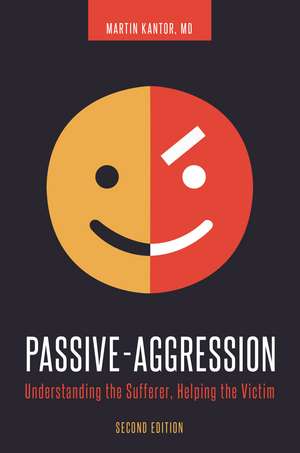Passive-Aggression: Understanding the Sufferer, Helping the Victim
Autor Martin Kantor MDen Limba Engleză Hardback – 2 oct 2017 – vârsta până la 17 ani
Preț: 358.85 lei
Preț vechi: 416.91 lei
-14% Nou
Puncte Express: 538
Preț estimativ în valută:
68.66€ • 71.70$ • 56.70£
68.66€ • 71.70$ • 56.70£
Carte tipărită la comandă
Livrare economică 15-29 aprilie
Preluare comenzi: 021 569.72.76
Specificații
ISBN-13: 9781440837906
ISBN-10: 1440837902
Pagini: 296
Dimensiuni: 156 x 235 x 21 mm
Greutate: 0.66 kg
Ediția:Revised
Editura: Bloomsbury Publishing
Colecția Praeger
Locul publicării:New York, United States
ISBN-10: 1440837902
Pagini: 296
Dimensiuni: 156 x 235 x 21 mm
Greutate: 0.66 kg
Ediția:Revised
Editura: Bloomsbury Publishing
Colecția Praeger
Locul publicării:New York, United States
Caracteristici
Covers a variety of treatment options and strategies-including cognitive, interpersonal, and psychoanalytic approaches as well as common transference and countertransference issues-that will aid victims of passive-aggressiveness and help passive-aggressive individuals themselves to do better
Notă biografică
Martin Kantor, MD, is a Harvard-trained psychiatrist who has been in full private practice in Boston and New York City and active in residency training programs at hospitals including Massachusetts General in Boston, MA, and Beth Israel in New York, NY.
Cuprins
AcknowledgmentsIntroduction: An OverviewPart 1 DescriptionChapter Making the DiagnosisChapter 2 Differential DiagnosisChapter 3 Anger Triggers: Reasons Why Passive-Aggressives Get So AngryChapter 4 More Reasons Why Passive-Aggressives Get So Angry (More Anger Triggers)Chapter 5 Reasons Passive-Aggressives Can Only Express Their Anger IndirectlyChapter 6 Anger StylesChapter 7 Other (Nonsyndromal) Anger Styles: Tactical, Cognitive-Behavioral, Interpersonal, and Biological FeaturesChapter 8 Pseudopassive-AggressivesPart 2 Victims of Passive-AggressivesChapter 9 PseudovictimsChapter 10 More Interactions Between Passive-Aggressives and Their VictimsChapter 11 SadomasochismPart 3 TreatmentChapter 12 Introduction to Treatment/Psychoanalytically Oriented PsychotherapyChapter 13 Cognitive TherapyChapter 14 Interpersonal TherapyChapter 15 Transference and Countertransference IssuesChapter 16 Victims of Passive-AggressionChapter 17 Helping Passive-Aggressives Become Less SoChapter 18 Anger ManagementNotesIndex
